Kathleen Jones's Blog, page 50
October 6, 2013
It's a book!
We've spent the last week putting the finishing touches to the Norman Nicholson biography. Neil has been polishing the book design and tweaking the colours for the cover and I've been reading the book again and again and again for typos and punctuation errors. Our big nightmare is that the book will arrive from the printers and we'll open it up and discover - oh horror!!! - that there is some really obvious mistake or omission on the first page. So, for a week, the dining table has looked like this, and we've been eating outside or on our laps.
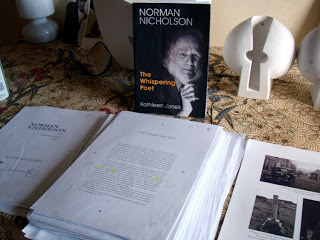
Putting a book like this together is complicated. Neil is doing the text in InDesign and he's had to learn about crop-marks and gutters and a million things you don't realise you have to know about books! We had to decide on what kind of paper to use (we've chosen book wove because it's thicker and has a nicer texture), whether to have the illustrations separately on glossy paper or in the text - we opted for the glossy sections, and what size the book should be. We can't afford to print a hardback, so have gone for an 'enhanced' paperback - thick card cover with fold-in flaps and the big 'trade paperback' size. Hopefully it will feel good and look good. This morning the files have been sent to the printers - a scary moment. There's no going back now.
The little plaster object on the right is the maquette of Neil's latest sculpture, which he might now get time to finish!

Putting a book like this together is complicated. Neil is doing the text in InDesign and he's had to learn about crop-marks and gutters and a million things you don't realise you have to know about books! We had to decide on what kind of paper to use (we've chosen book wove because it's thicker and has a nicer texture), whether to have the illustrations separately on glossy paper or in the text - we opted for the glossy sections, and what size the book should be. We can't afford to print a hardback, so have gone for an 'enhanced' paperback - thick card cover with fold-in flaps and the big 'trade paperback' size. Hopefully it will feel good and look good. This morning the files have been sent to the printers - a scary moment. There's no going back now.
The little plaster object on the right is the maquette of Neil's latest sculpture, which he might now get time to finish!
Published on October 06, 2013 23:36
October 5, 2013
To cut a long story short - publishing short fiction
I'm blogging over at
Authors Electric
today, about the short story publishing scene for writers and readers. There's a new competition for crime writers and a free story . . .
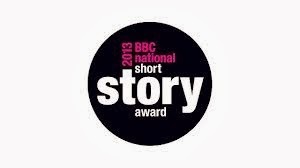
'The short list for the BBC National Short Story Award has just been announced and it's a shocker! There are no men on it... (David Gilmour take note) At £15,000 this is one of the most valuable prizes in literature, and it emphasises the short story's status as a literary art form. The high value we place on the short story is a big contrast with its lack of appeal as a commercial publishing prospect. Fewer and fewer publishers are accepting them and then only as a gesture towards their best-selling authors. Newspaper and magazine outlets have also dwindled.
But, readers like short stories and writers like writing them. The result is a flourishing Indie-publishing scene for short fiction - not just in book form, but also in E-zines and blogs and Facebook groups. People are reading Flash fiction on their mobile phones and downloading stories onto their I-pads from sites where you can read any kind of fiction from erotic to murderous, and cozy to experimental. There are markets for the short story everywhere on the internet. Unfortunately very few of them pay anything . . .' ( To read more click here )

'The short list for the BBC National Short Story Award has just been announced and it's a shocker! There are no men on it... (David Gilmour take note) At £15,000 this is one of the most valuable prizes in literature, and it emphasises the short story's status as a literary art form. The high value we place on the short story is a big contrast with its lack of appeal as a commercial publishing prospect. Fewer and fewer publishers are accepting them and then only as a gesture towards their best-selling authors. Newspaper and magazine outlets have also dwindled.
But, readers like short stories and writers like writing them. The result is a flourishing Indie-publishing scene for short fiction - not just in book form, but also in E-zines and blogs and Facebook groups. People are reading Flash fiction on their mobile phones and downloading stories onto their I-pads from sites where you can read any kind of fiction from erotic to murderous, and cozy to experimental. There are markets for the short story everywhere on the internet. Unfortunately very few of them pay anything . . .' ( To read more click here )
Published on October 05, 2013 02:30
October 4, 2013
The Fall of Berlusconi
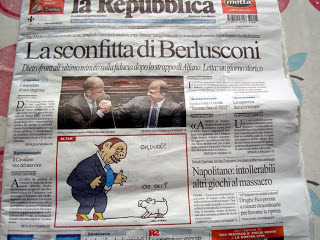
Result!! Berlusconi's attempt to bring down the coalition headed by Enrico Letta has failed. Some of his own party members even voted for Letta. Now, even his dog doesn't want to know him!
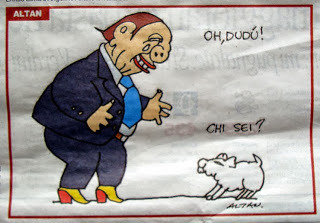 'Oh, Dudu!'..... 'Who are you?'
'Oh, Dudu!'..... 'Who are you?'Note the tears, the botoxed, lipsticked lips (he's rumoured to wear make-up), the hair dye and the high heels (he's also rumoured to give himself an extra inch or so). Today, a committee decides on his 'decadence'. Having already incurred several prison sentences for tax fraud and having sex with an underage girl, his political career shouldn't even be under discussion. But this is Italy. I asked Stefano, an educated, liberal man who has spent time in England whether Berlusconi's fall was a good thing for Italy. He answered 'Yes and No.' Which sums up Italian politics! Is this the final curtain for Il Cavaliere? Who knows - he has already had more resuscitations than a vampire.
 Recent art installation featuring a life-like figure.
Recent art installation featuring a life-like figure.Meanwhile, the Italian press is full of the tragedy that happened last night when a boat carrying illegal migrants caught fire and sank off the island of Lampedusa with more than a hundred deaths. Italy simply doesn't know how to cope with the hordes of poor and hungry who risk their lives to cross the Mediterranean for the chance of a better life. Forty per cent of young people in Italy don't have a job. There are beggars and illegal street traders in every town, many of them from Albania, Romania and Africa. Things really are a mess here, but a stable government able to deal with them seems to be a dream too far.
Published on October 04, 2013 05:03
October 2, 2013
National Poetry Day: Talking to Seamus Heaney - Stepping Stones
It's National Poetry Day today in Britain, so, to celebrate, I thought I'd share some thoughts on Stepping Stones, edited by Dennis O'Driscoll, published by Faber.
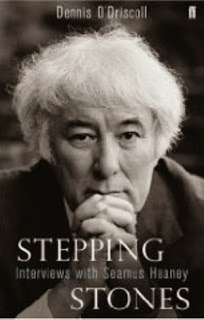 I'd started reading the late Dennis O'Driscoll's conversations with Seamus Heaney at the end of last year and I've been dipping into it for months (it's a big book), savouring the autobiographical narrative and the lively discussions on Life, Poetry, Irish politics and Everything. But when Seamus Heaney so unexpectedly died, I went back to
Stepping Stones
and began reading again from the beginning with closer attention. Suddenly, in the light of the poet's death, what he had to say seemed more definitive.
I'd started reading the late Dennis O'Driscoll's conversations with Seamus Heaney at the end of last year and I've been dipping into it for months (it's a big book), savouring the autobiographical narrative and the lively discussions on Life, Poetry, Irish politics and Everything. But when Seamus Heaney so unexpectedly died, I went back to
Stepping Stones
and began reading again from the beginning with closer attention. Suddenly, in the light of the poet's death, what he had to say seemed more definitive.
He addresses the question 'how should a poet live and write? What is his relationship to be to his own voice, his own place, his literary heritage and his contemporary world?' The pronoun is male, but the prose is inclusive. It's a journey into what Seamus called 'the wideness of language, a journey where each point of arrival - whether in one's poetry or one's life - turned out to be a stepping stone rather than a destination'.
I also bought Opened Ground - Seamus Heaney's Selected Poems - so that I could follow discussions of the individual poems, the histories of various collections, and the contexts of each piece of work. Somehow I managed to juggle backwards and forwards between the two books on my Kindle, absorbed in the poems and by Seamus' vivid account of the genesis of each poem and its reference points.
Seamus talks a lot about his childhood on the small farm in northern Ireland - the eldest of 9 children, living with parents and an aunt, crammed into accommodation that today would be thought suitable only for a family of four. Brought up myself, on a small farm worked by horses, with no modern conveniences or machinery, I could see, effortlessly, the byres and the barns, the flagged floors and the old stoves. I, too, lay awake listening to the horses stamping in the stable next door, the cows rattling their chains in the winter byres. This is the stuff of Seamus' early poetry, the roots that nurtured him all his life. The farm kitchen is so real, I can smell the bread rising.
.... the sun stood
like a griddle cooling against the wall
of each long afternoon.
So, her hands scuffled
over the bakeboard,
the reddening stove
sent its plaque of heat
against where she stood
in a floury apron
by the window.
Now she dusts the board
with a goose's wing,
now sits, broad-lapped,
with whitened nails
and measling shins:
here is a space
again, the scone rising
to the tick of two clocks.
He chose not to go to England to University and remained in Ireland, working initially as a teacher rather than an academic. Though he accepted university posts as a poet in residence - notably in America and at Oxford - there's a marked distrust of academic life and the incestuous nature of the creative writing culture. Dennis asked him if he thought that a 'career-based life in the creative writing schools undermines poetry as a vocational activity'. This is Seamus' response.
'For some people, certainly. In the States during those sessions of questions from the audience when the visiting poet is asked about other poets he or she admires, the names given are rarely those of the great dead. Usually you hear about people at other writing schools, people who are at the centre of webs, good enough representatives of the contemporary scene, but proof of what Donald Davie once termed - in another context - 'lowered sights and diminished expectations'. There are times when you realise that the guild now consists as much of networkers as dreamworkers'.
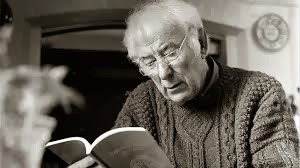
Dennis O'Driscoll asks the questions that readers want to have answers to, both public and private. Where did Seamus sit in Northern Irish politics? What was his relationship with his family, his wife, the poetry community? And the responses are beautifully edited to preserve Seamus Heaney's natural voice - the flow of thought.
This is an autobiography - as told by Seamus Heaney to Dennis O'Driscoll - and it's not only magical to read, it illuminates the poetry. Essential reading for all Heaney fans. And - unlike some other expensive tomes - the Kindle edition is only £5.99.
Stepping Stones
Interviews with Seamus Heaney
Dennis O'Driscoll
 I'd started reading the late Dennis O'Driscoll's conversations with Seamus Heaney at the end of last year and I've been dipping into it for months (it's a big book), savouring the autobiographical narrative and the lively discussions on Life, Poetry, Irish politics and Everything. But when Seamus Heaney so unexpectedly died, I went back to
Stepping Stones
and began reading again from the beginning with closer attention. Suddenly, in the light of the poet's death, what he had to say seemed more definitive.
I'd started reading the late Dennis O'Driscoll's conversations with Seamus Heaney at the end of last year and I've been dipping into it for months (it's a big book), savouring the autobiographical narrative and the lively discussions on Life, Poetry, Irish politics and Everything. But when Seamus Heaney so unexpectedly died, I went back to
Stepping Stones
and began reading again from the beginning with closer attention. Suddenly, in the light of the poet's death, what he had to say seemed more definitive.He addresses the question 'how should a poet live and write? What is his relationship to be to his own voice, his own place, his literary heritage and his contemporary world?' The pronoun is male, but the prose is inclusive. It's a journey into what Seamus called 'the wideness of language, a journey where each point of arrival - whether in one's poetry or one's life - turned out to be a stepping stone rather than a destination'.
I also bought Opened Ground - Seamus Heaney's Selected Poems - so that I could follow discussions of the individual poems, the histories of various collections, and the contexts of each piece of work. Somehow I managed to juggle backwards and forwards between the two books on my Kindle, absorbed in the poems and by Seamus' vivid account of the genesis of each poem and its reference points.
Seamus talks a lot about his childhood on the small farm in northern Ireland - the eldest of 9 children, living with parents and an aunt, crammed into accommodation that today would be thought suitable only for a family of four. Brought up myself, on a small farm worked by horses, with no modern conveniences or machinery, I could see, effortlessly, the byres and the barns, the flagged floors and the old stoves. I, too, lay awake listening to the horses stamping in the stable next door, the cows rattling their chains in the winter byres. This is the stuff of Seamus' early poetry, the roots that nurtured him all his life. The farm kitchen is so real, I can smell the bread rising.
.... the sun stood
like a griddle cooling against the wall
of each long afternoon.
So, her hands scuffled
over the bakeboard,
the reddening stove
sent its plaque of heat
against where she stood
in a floury apron
by the window.
Now she dusts the board
with a goose's wing,
now sits, broad-lapped,
with whitened nails
and measling shins:
here is a space
again, the scone rising
to the tick of two clocks.
He chose not to go to England to University and remained in Ireland, working initially as a teacher rather than an academic. Though he accepted university posts as a poet in residence - notably in America and at Oxford - there's a marked distrust of academic life and the incestuous nature of the creative writing culture. Dennis asked him if he thought that a 'career-based life in the creative writing schools undermines poetry as a vocational activity'. This is Seamus' response.
'For some people, certainly. In the States during those sessions of questions from the audience when the visiting poet is asked about other poets he or she admires, the names given are rarely those of the great dead. Usually you hear about people at other writing schools, people who are at the centre of webs, good enough representatives of the contemporary scene, but proof of what Donald Davie once termed - in another context - 'lowered sights and diminished expectations'. There are times when you realise that the guild now consists as much of networkers as dreamworkers'.

Dennis O'Driscoll asks the questions that readers want to have answers to, both public and private. Where did Seamus sit in Northern Irish politics? What was his relationship with his family, his wife, the poetry community? And the responses are beautifully edited to preserve Seamus Heaney's natural voice - the flow of thought.
This is an autobiography - as told by Seamus Heaney to Dennis O'Driscoll - and it's not only magical to read, it illuminates the poetry. Essential reading for all Heaney fans. And - unlike some other expensive tomes - the Kindle edition is only £5.99.
Stepping Stones
Interviews with Seamus Heaney
Dennis O'Driscoll
Published on October 02, 2013 12:28
September 30, 2013
The end of the creative writing retreat at Peralta
It's over again for another year - a week with eleven enthusiastic writers from all over the world - this time from Bangkok, Singapore, Canada, Scotland, England and the USA. The weather was wonderful. We worked together, lunched together ....
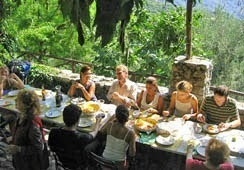
watched the sunset together
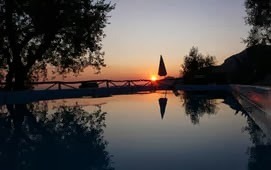
and had dinner together by candlelight.
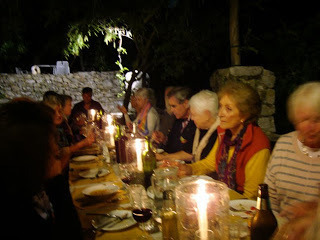
And Peralta worked its magic on us all as it usually does. For me there were added treats. Remember Batcat's last kitten?
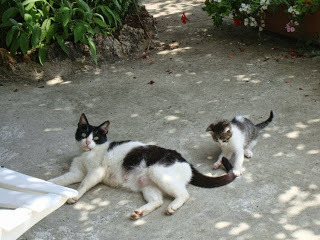
Well, he now looks like this ... Quite a beast!
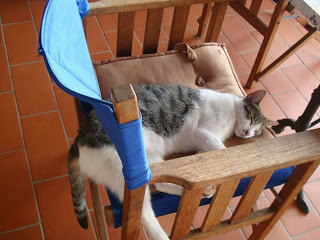
The course next year will be in the middle of September, 2014, dates to be arranged.
Creative Writing Retreats, painting courses and holidays at Peralta, Tuscany.

watched the sunset together

and had dinner together by candlelight.

And Peralta worked its magic on us all as it usually does. For me there were added treats. Remember Batcat's last kitten?

Well, he now looks like this ... Quite a beast!

The course next year will be in the middle of September, 2014, dates to be arranged.
Creative Writing Retreats, painting courses and holidays at Peralta, Tuscany.
Published on September 30, 2013 09:08
September 29, 2013
Bach in Pisa Cathedral
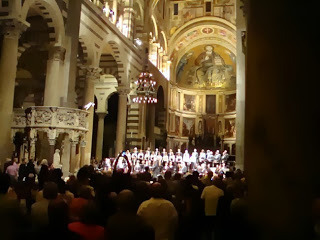
A glorious way to end the week. It doesn't get much better than this - Bach's Mass in B Minor, sung by the Monteverdi choir, conducted by John Eliot Gardner. This is the Anima Mundi Festival in Pisa, and we had to queue for hours to get the tickets! But at least they were free, so we didn't mind. That's me in glasses at the bottom left. Notice the Italian queue which is about thirty people wide!
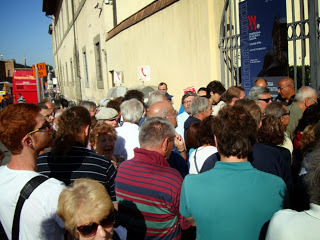
When we arrived, musicians were playing up on the Leaning Tower - lovely strains of Bach and Vivaldi floating out over the lawns.
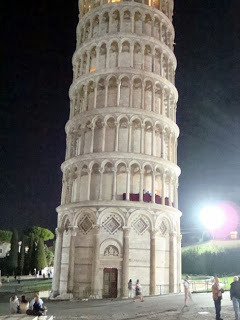
The floodlit Duomo is quite awe-inspiring at night.
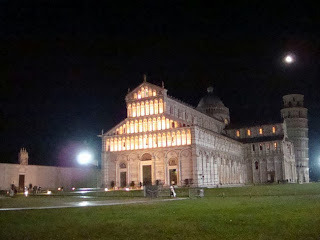
Inside, it was utterly beautiful - every corner lit for us to look at without having to pay the big ticket fees tourists have to buy.
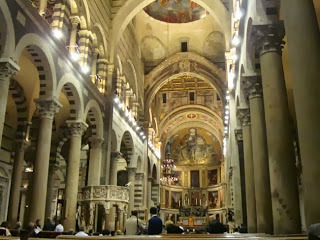
And the choir and baroque musicians got a standing ovation at the end that lasted for 15 minutes.
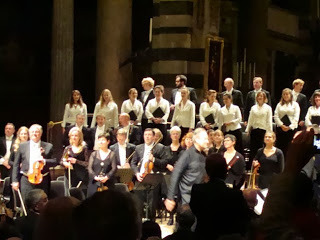
Today, I'm back at Capezzano Monte after the end of the creative writing retreat, watching the thunder and lightning outside the windows. The rain is torrential. A good excuse to curl up with a book or catch up on all the emails I haven't answered this week!
Published on September 29, 2013 06:38
September 21, 2013
Playing Truant in Pisa
I’ve been playing truant again - this time in Pisa. I left ‘Norman’ as a pile of pdf proofs on the dining table and caught the train into town.
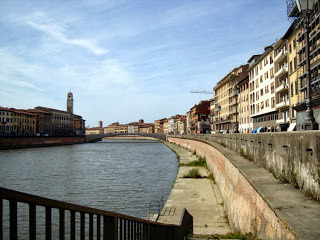
Pisa is a lovely city, arranged on either side of the river Arno - medieval and baroque buildings sitting side by side in complete harmony, painted in those ochre colours the Italians use so that the street looks like a sunset. Pisa is much more peaceful than Florence, and you can slip down flights of stone steps to sit beside the river and quietly read a book in the sun.
One of my favourite places is the Museo Communale - an old Benedictine Monastery fronting onto the Arno. Hardly anyone seems to find it - the man in the ticket office was fast asleep at his desk as I tiptoed past. As usual, I had the museum all to myself. It was founded as a monastery for women in 1017 and has a very quiet, sun-filled cloister.
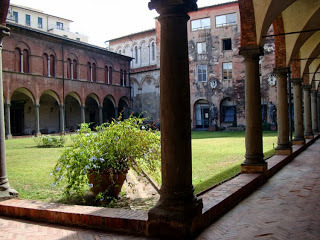
Everywhere you look there are women clutching books. This is a marble tomb lid from 1384.
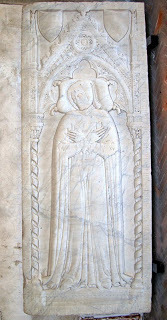
St Eulalia da Barcelona, with stars on her gown, by Bicci da Lorenzo.
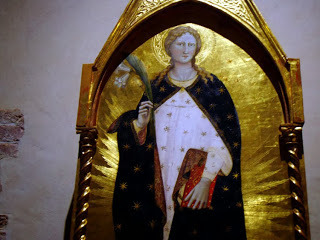
The museum is famous for its collection of 13th and 14th century gilded icons. This isn’t a very good photograph because of the low lighting and the need to take pictures without flash, but it gives some idea of what's there.
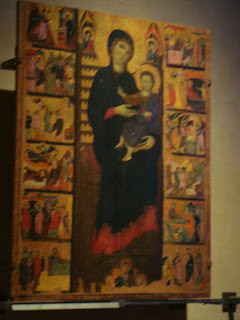
In a darkened room at the back, is a collection of very special wooden figures - annunciation scenes – carved back in the 14th century - some of them by Andrea Pisano. They are very simple. Here, Mary is just an ordinary girl in a cotton dress with her hair down her back, modelled from one of the local girls.
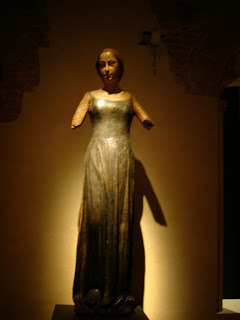
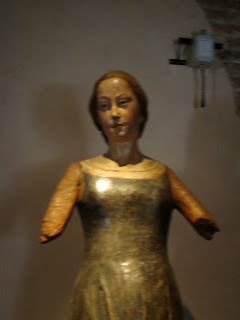
The nuns seem to have had a good time, in spite of their seclusion - this is one of the wine vats in the courtyard!
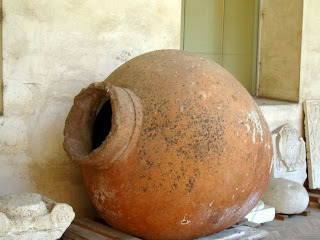
If you ever get to Pisa, do try to get to this Museum - it's a hidden treasure.
Now, I'm off to Peralta to lead a creative writing retreat with American novelist Mary-Rose Hayes. We have a full house, so it's going to be an intense week.

Pisa is a lovely city, arranged on either side of the river Arno - medieval and baroque buildings sitting side by side in complete harmony, painted in those ochre colours the Italians use so that the street looks like a sunset. Pisa is much more peaceful than Florence, and you can slip down flights of stone steps to sit beside the river and quietly read a book in the sun.
One of my favourite places is the Museo Communale - an old Benedictine Monastery fronting onto the Arno. Hardly anyone seems to find it - the man in the ticket office was fast asleep at his desk as I tiptoed past. As usual, I had the museum all to myself. It was founded as a monastery for women in 1017 and has a very quiet, sun-filled cloister.

Everywhere you look there are women clutching books. This is a marble tomb lid from 1384.

St Eulalia da Barcelona, with stars on her gown, by Bicci da Lorenzo.

The museum is famous for its collection of 13th and 14th century gilded icons. This isn’t a very good photograph because of the low lighting and the need to take pictures without flash, but it gives some idea of what's there.

In a darkened room at the back, is a collection of very special wooden figures - annunciation scenes – carved back in the 14th century - some of them by Andrea Pisano. They are very simple. Here, Mary is just an ordinary girl in a cotton dress with her hair down her back, modelled from one of the local girls.


The nuns seem to have had a good time, in spite of their seclusion - this is one of the wine vats in the courtyard!

If you ever get to Pisa, do try to get to this Museum - it's a hidden treasure.
Now, I'm off to Peralta to lead a creative writing retreat with American novelist Mary-Rose Hayes. We have a full house, so it's going to be an intense week.
Published on September 21, 2013 07:26
September 18, 2013
Up the River Without any Water
I've not been very active on here recently, mainly because Neil and I have been doing a marathon to get the Norman Nicholson biography out of the house and into the Printer's hands. Proof-reading is a tedious and time-consuming business, reading word by word, line by line, checking every comma and stop. We're trying to get it as perfect as we can. And Neil has been tweaking the type-setting in InDesign, finding all kinds of glitches. But we're almost there and felt able to give ourselves a day off.
We decided to go up the big river that flows down from the marble mountains, where there are several waterfalls and swimming pools where you can cool off on a hot afternoon. Neil also wanted to look for some big marble cobbles to carve into small pieces of sculpture. When we got to the river, we got quite a shock - no shortage of pebbles, but a definite absence of water!
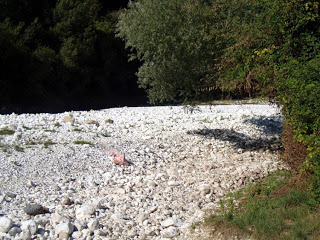
And this is the river further up - some muddy streaks, presumably from the thunderstorms we had a week ago, but not even damp.
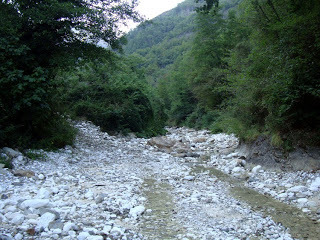
The waterfalls are high and dry.
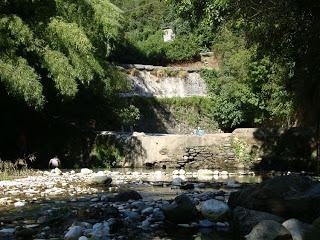
But at the base of the falls, there's a pool of turquoise water where the river has gone underground and is trickling out at the bottom. Enough to paddle!
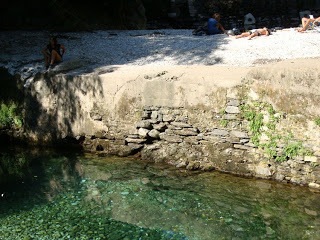
Italy is very much in need of rain, but it's coming - summer has broken and we're getting thunderstorms and cloudy days. Just as I'm posting this, I can hear rain pattering down on the terrace outside. Hopefully the river will be back in full flow in a couple of months.
We decided to go up the big river that flows down from the marble mountains, where there are several waterfalls and swimming pools where you can cool off on a hot afternoon. Neil also wanted to look for some big marble cobbles to carve into small pieces of sculpture. When we got to the river, we got quite a shock - no shortage of pebbles, but a definite absence of water!

And this is the river further up - some muddy streaks, presumably from the thunderstorms we had a week ago, but not even damp.

The waterfalls are high and dry.

But at the base of the falls, there's a pool of turquoise water where the river has gone underground and is trickling out at the bottom. Enough to paddle!

Italy is very much in need of rain, but it's coming - summer has broken and we're getting thunderstorms and cloudy days. Just as I'm posting this, I can hear rain pattering down on the terrace outside. Hopefully the river will be back in full flow in a couple of months.
Published on September 18, 2013 11:07
September 7, 2013
'The Assyrian came down like the wolf on the fold . . . .'
I've always remembered this line from Byron's poem 'The Destruction of Sennacherib' - it's the description of a siege and a miraculous deliverance. Assyrian history claims that they won without significant losses; the Bible claims that 18,000 Assyrians were wiped out by the Angel of Death. No one knows which account is true, all we know is that there was a battle. The Middle East has been an arena of conflict for thousands of years.
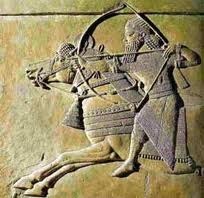
Italy is a relatively peaceful place, but every time I look out over the Mediterranean from our terrace I'm reminded that just across the water, things are very different. The tragedy that Syria has become, is constantly on my mind, and almost every news item reports another bomb in Iraq. Syria, Iraq and Iran hold some of the most ancient and significant archaeological sites in the 'modern' world. These early civilisations are thought to be where our ancestors learned how to live together in cities and move from a nurturing, land-based culture to an urban, more stratified society. This society was not peaceful. The Assyrians in particular were ferocious conquerors. Their kings had the ambition to rule a great empire stretching across the middle-east.
Whenever I go to London I try to get into the British Museum, and one of the sections I head for is the one containing the Assyrian rooms. Here, the palaces and temples of Nimrud (roughly situated in what is now Iraq) have been reconstructed so that you can walk through. Nimrud, which dates from roughly 800-860 BC) was plundered by archaeologists - a theft I feel rather bad about - but that has to be balanced by the knowledge that if the artefacts were still in Iraq I wouldn't be seeing them. They also record violent events and a bloodthirsty code of honour and that knowledge is always in conflict with my appreciation of Assyrian art. These reliefs and sculptures are some of the most beautiful works of art I've ever seen.
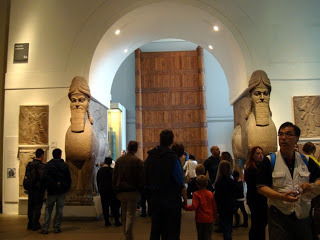
These are the Winged Sphinxes guarding the gates of Nimrud. The original bronze hinges and decorations are on display beside the re-construction.
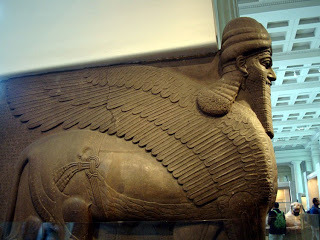
One of the Winged Sphinxes
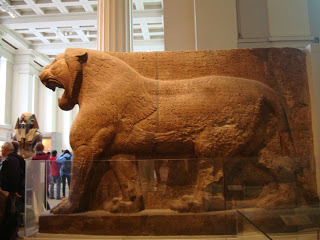
The Lion was a potent symbol of Assyria.
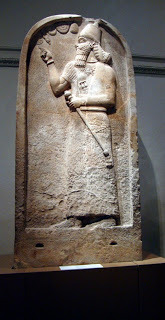 The Assyrian King Ashurnasirpal - he is pointing up to the symbols of the Assyrian gods - Assur, Shamash, Sin, Adad and Ishtar. Ishtar was not a peaceful, nurturing female goddess, but one of war.
The Assyrian King Ashurnasirpal - he is pointing up to the symbols of the Assyrian gods - Assur, Shamash, Sin, Adad and Ishtar. Ishtar was not a peaceful, nurturing female goddess, but one of war.
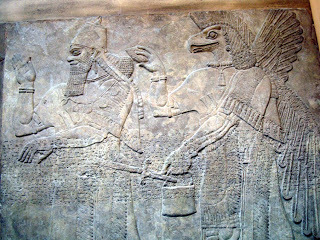
This is King Ashurnasirpal with the Assyrian god of agriculture, Nisroch. (Apparently King Sennacherib was assassinated by his sons in the temple of Nisroch.)
Around Ashurnasirpal's palace, on every wall, runs the inscription: 'I am important, I am magnificent . . .the great king, the mighty king, king of the world, king of Assyria . . . I am the king who has brought into submission at his feet the lands from beyond the Tigris to Mount Lebanon and the Great Sea . . . who by his lordly attack has forced fierce and merciless kings . . . with their blood I dyed the mountains red as red wool, while the ravines and torrents of the mountain swallowed the rest of them'. Hundreds of thousands were slaughtered in Ashurnasirpal's quest for absolute domination. The numbers mentioned refer only to the menfolk - who knows how many women and children were obliterated as villages and towns were razed to the ground.
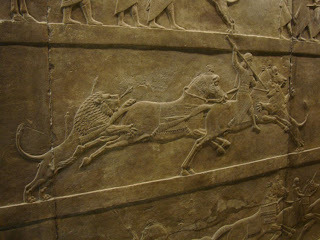 When they weren't hunting down people, they were killing animals for fun. This is a lion hunt.
When they weren't hunting down people, they were killing animals for fun. This is a lion hunt.
Normal life had to go on somehow - the Nimrud reliefs also celebrate ordinary people's lives. This is a camel herd.
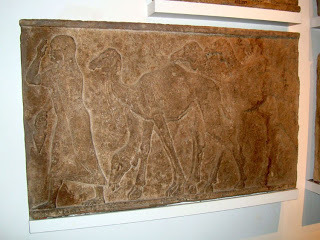
And domestic animals.
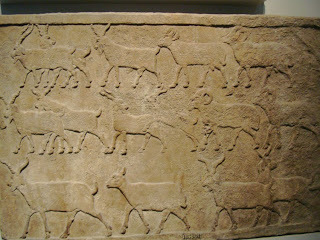
This case always fascinates me - it contains the tablets buried in the floor of the temple of Manu, God of Dreams.
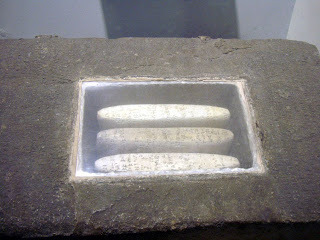
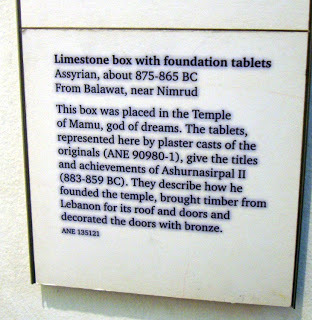
So, nothing has changed in the Middle East in 3,000 years. Tragic.

Italy is a relatively peaceful place, but every time I look out over the Mediterranean from our terrace I'm reminded that just across the water, things are very different. The tragedy that Syria has become, is constantly on my mind, and almost every news item reports another bomb in Iraq. Syria, Iraq and Iran hold some of the most ancient and significant archaeological sites in the 'modern' world. These early civilisations are thought to be where our ancestors learned how to live together in cities and move from a nurturing, land-based culture to an urban, more stratified society. This society was not peaceful. The Assyrians in particular were ferocious conquerors. Their kings had the ambition to rule a great empire stretching across the middle-east.
Whenever I go to London I try to get into the British Museum, and one of the sections I head for is the one containing the Assyrian rooms. Here, the palaces and temples of Nimrud (roughly situated in what is now Iraq) have been reconstructed so that you can walk through. Nimrud, which dates from roughly 800-860 BC) was plundered by archaeologists - a theft I feel rather bad about - but that has to be balanced by the knowledge that if the artefacts were still in Iraq I wouldn't be seeing them. They also record violent events and a bloodthirsty code of honour and that knowledge is always in conflict with my appreciation of Assyrian art. These reliefs and sculptures are some of the most beautiful works of art I've ever seen.

These are the Winged Sphinxes guarding the gates of Nimrud. The original bronze hinges and decorations are on display beside the re-construction.

One of the Winged Sphinxes

The Lion was a potent symbol of Assyria.
 The Assyrian King Ashurnasirpal - he is pointing up to the symbols of the Assyrian gods - Assur, Shamash, Sin, Adad and Ishtar. Ishtar was not a peaceful, nurturing female goddess, but one of war.
The Assyrian King Ashurnasirpal - he is pointing up to the symbols of the Assyrian gods - Assur, Shamash, Sin, Adad and Ishtar. Ishtar was not a peaceful, nurturing female goddess, but one of war.
This is King Ashurnasirpal with the Assyrian god of agriculture, Nisroch. (Apparently King Sennacherib was assassinated by his sons in the temple of Nisroch.)
Around Ashurnasirpal's palace, on every wall, runs the inscription: 'I am important, I am magnificent . . .the great king, the mighty king, king of the world, king of Assyria . . . I am the king who has brought into submission at his feet the lands from beyond the Tigris to Mount Lebanon and the Great Sea . . . who by his lordly attack has forced fierce and merciless kings . . . with their blood I dyed the mountains red as red wool, while the ravines and torrents of the mountain swallowed the rest of them'. Hundreds of thousands were slaughtered in Ashurnasirpal's quest for absolute domination. The numbers mentioned refer only to the menfolk - who knows how many women and children were obliterated as villages and towns were razed to the ground.
 When they weren't hunting down people, they were killing animals for fun. This is a lion hunt.
When they weren't hunting down people, they were killing animals for fun. This is a lion hunt.Normal life had to go on somehow - the Nimrud reliefs also celebrate ordinary people's lives. This is a camel herd.

And domestic animals.

This case always fascinates me - it contains the tablets buried in the floor of the temple of Manu, God of Dreams.


So, nothing has changed in the Middle East in 3,000 years. Tragic.
Published on September 07, 2013 06:59
September 5, 2013
Ash Cameron talks about 'Undercover Cop' and being published by the Friday Project
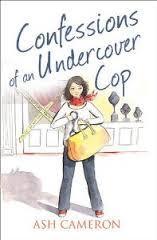
I'm blogging over at Authors Electric today - an interview with Ash Cameron, author of the soon-to-be-published 'Undercover Cop'. She was one of my most talented creative writing students and has been sending out her short stories and winning competitions for a few years now, until a chance meeting on Twitter led to the book contract. . . . Read how it happened here.
Published on September 05, 2013 01:19



